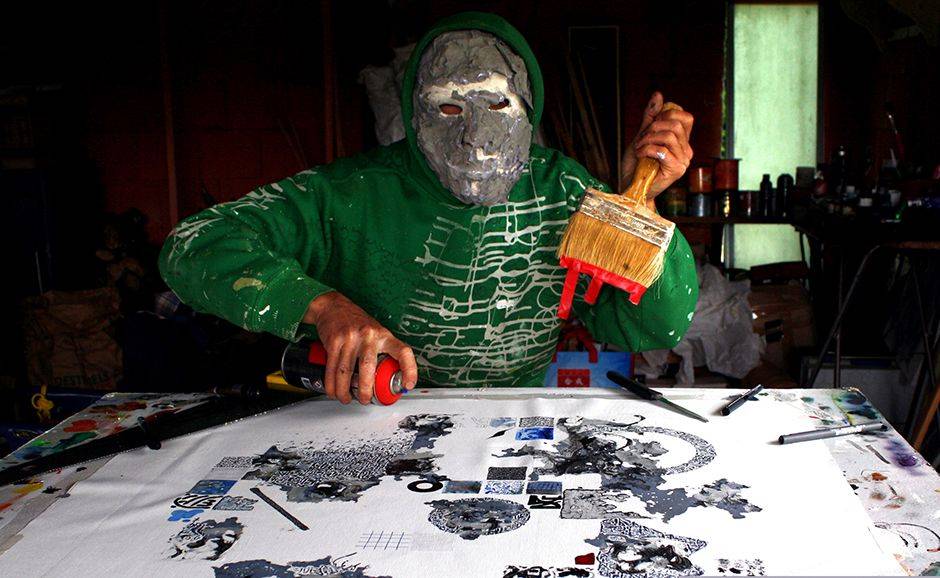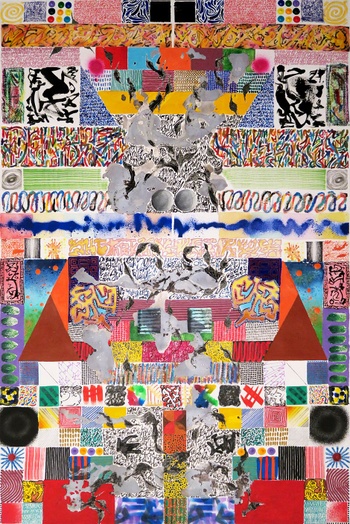The world is flooded with images and like living snapshots, we are in danger of drowning too. In “Images vivantes”, the artistic trio Parole, Obêtre, and Luis Pôlet are going on the offensive by diving head-first into a defiant hybrid.

Artists Parole, Obêtre and Pôlet save the world from drowning in images
Life is a messy thing. It overwhelms you, retreats, spills over the edge, and veils itself in new languages, various forms, different shapes. It doesn’t follow rigid, linear structures, it does not allow itself to be forced into artificial boundaries or to be curbed by expectations. It constantly draws outside the lines. Now replace the word “life” with “art” and you will discover a trace of what “Images vivantes” aims to do.
For this exhibition, artists Parole, Obêtre, and Luis Pôlet – under the curatorship of Sébastien Marandon, and accompanied by art historians, photographers, musicians, dancers, “Metteurs en Pièces”, and pupils from the Institut Sainte-Marie secondary art school – are grappling with that unpredictable, unrestrainable but o so liberating life with a reflection, an intuition, and an artistic practice that explores that very life. It is nothing less than a revolutionary deed in this age of visual excess, selfies, and social media, where images increasingly seem to wrap themselves around life like a shell, a detailed and calculated skin that seems to correspond more to a marketable public image rather than to express the sensual, uncontrollable that it envelops as an identity.
In contrast to this likeness, in which we appear more than we live and which we now produce more than we contemplate it, Parole, Obêtre, and Luis Pôlet propose radical exploration and dialogue. In the words of curator Sébastien Marandon, “‘Images vivantes’ aims to investigate the various kinds of images, their habitat, their forms of interaction, reproduction, and evolution, and to contrast these with our own counter-images.” It is an interplay of dancing images, digital and analogue pictures, bodies, performances, films, illegal, underground, and hybrid images…an iconoclasm to reveal, collide with, oppose, reflect upon, and draw life from. A wild and bewildering experience on various interconnected levels and registers that allows us to rethink (the relationship between) images, society, and ourselves.

The binding agent of the cultural building site that is “Images vivantes” consists of the trio of artists, their shared history, and their interrelated manners of expression. From Parole’s ever-changing alphabet and enticing calligraffiti, to Obêtre’s stupefying graffitecture, and finally Luis Pôlet’s poetic explorations in ink, all three of them resist the homogeneity and the expressionless blare of society and city in favour of an artistic practice that is alive, responds to coincidences and experiences, and tenaciously searches for a critical mass that positions us in society.
Parole: “We shared a studio on Waversesteenweg/chaussée de Wavre for a while, and subconsciously influenced each other all that time. Sébastien was struck by the dialogue of form and content that we were pursuing and decided to showcase it here.” Luis Pôlet: “We have exhibited together, and travelled to China and Latin America in alternating constellations… Since our communal studio in the Gésu church, we have shared the past decade of history.”
That history is now coalescing in a universe that is celebrating hybridity. “You could definitely call it maddening,” Luis Pôlet laughs. “Very concretely, we have created a universe based on a fictional, multifaceted character who represents the project and its participants. POP’S is both everything and nothing, a coherent force with many faces. He is a tagger, a philosopher, a politician, a draughtsman… He is everyone, a structure that you can appropriate and that can incarnate everyone.”
“It is total schizophrenia,” Parole adds. “We are not showing our own work, but getting into one another’s heads. And we take it pretty far. So far even that I have metamorphosed into Luis making an Obêtre.” Luis Pôlet: “When you inhabit somebody else’s mind, you force yourself to see the world differently. As an artist, you outline a set of rules, constraints even, that create your own comfortable little world. Having to question that and allowing yourself to be taken over by someone else and to disappear yourself so that you can become something else, changes everything. You start asking the most basic questions again. What are we surrounded by? How do you relate to that world? What is an image in that context? What is colour?”
Parole: “It is also an expression of the fact that we need others. I am very happy in my studio, but I really need to dialogue with people, to discover new techniques, and to inhabit different worlds where I can become someone else. Collaborating with Sophie [Saporosi, who along with Ian Dykmans and Silvano Magnone makes up the trio of photographers who made a hybrid portrait of the artists, ks] really inspired me. And it found its way into my work. Parole is a lot of different people.”
Luis Pôlet: “Sometimes you are shut up in your studio for three days, and you only realise later that you haven’t said a word in all that time. It’s dreadful. I am perfectly happy without something looking over my shoulder all the time. Thanks but no thanks. But in the end, on your own you are nobody. Well, me at least. [Laughs] Which doesn’t mean that the fake Pôlets don’t make me green with envy. Parole and Obêtre made my work better than I can make it. Terrible!”
The “living images” from the title can be understood in multiple ways. Luis Pôlet: “What is life? What makes images alive? The recognition of another? Economic value? Someone else’s look? Sébastien extends the whole concept to drone images, cyborgs, and that kind of thing. That gradually leads you into the hybridisation of beings and identities, which we are stimulating here. But how all this ultimately turns out is still a mystery.”
The hybrid state is one that defies standardisation and allows for another way of looking, creating, and living to surface. Parole: “I am most interested in human traces. In an urban environment that is easily decontaminated, like a kind of Disney World, where whatever operates outside the standards is forbidden, those traces are vitally important. The world, humanity, beauty…that is what it’s all about. To elevate and reinforce the things that are really there, an essence.”
> Images vivantes, 2 > 23/6, LesbroussART Gallery, Elsene/Ixelles
Read more about: Expo
Fijn dat je wil reageren. Wie reageert, gaat akkoord met onze huisregels. Hoe reageren via Disqus? Een woordje uitleg.